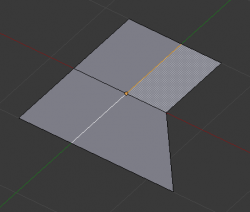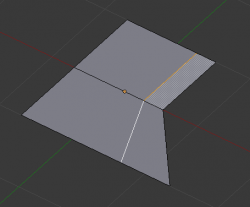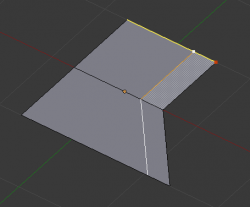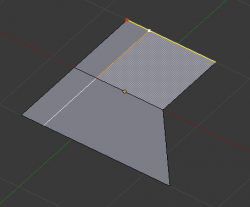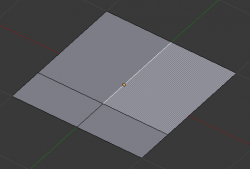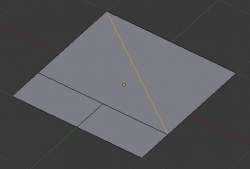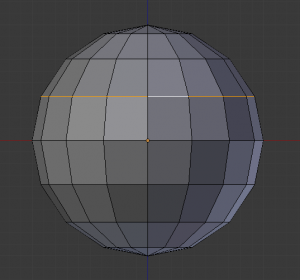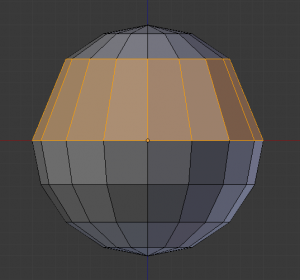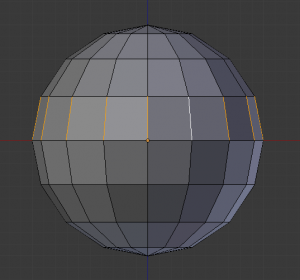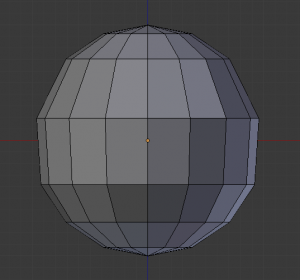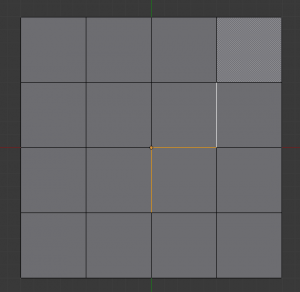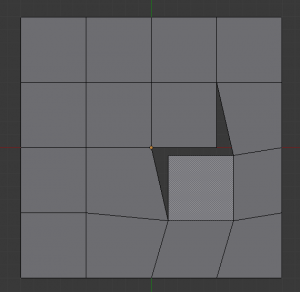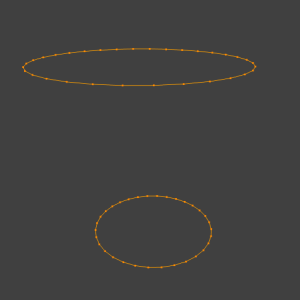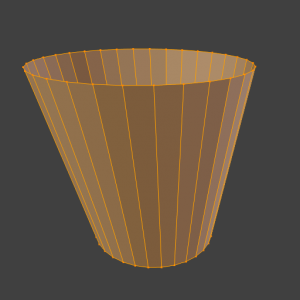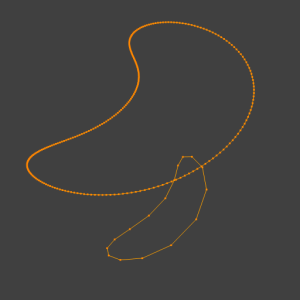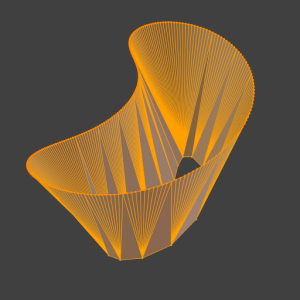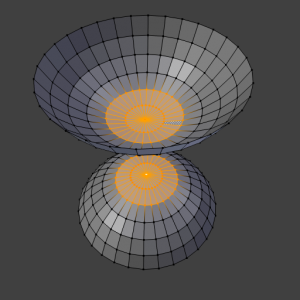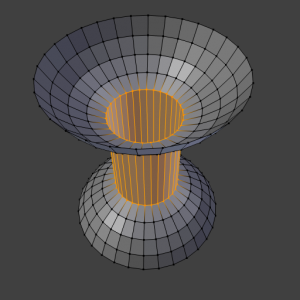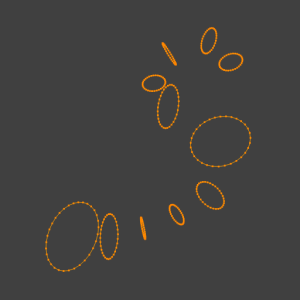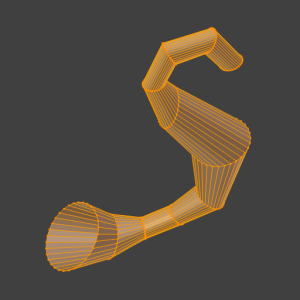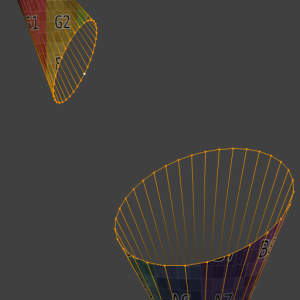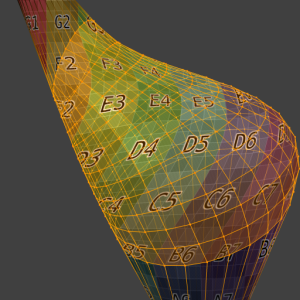Doc:2.6/Manual/Modeling/Meshes/Editing/Edges
Page status (reviewing guidelines)
Page reviewed and in good shape |
目次
Make Edge/Face
Mode: Edit mode
Hotkey: F
Menu: Mesh » Edges » Make Edge/Face
It will create an edge or some faces, depending on your selection. We have already discussed this tool in the editing basics page.
Set Edge Attributes
Edges can have several different attributes that influence how varying tools affect the mesh.
Mark Seam and Clear Seam
Mode: Edit mode (Vertex or Edge select modes)
Hotkey: CtrlE6 NumPad and CtrlE7 NumPad
Menu: Mesh » Edges » Mark Seam/Clear Seam (or the same options in Edge Specials menu)
Seams are a way to create separations, “islands”, in UV maps. See the UVTexturing section for more details. These commands set or unset this flag for selected edges.
Mark Sharp and Clear Sharp
Mode: Edit mode (Vertex or Edge select modes)
Hotkey: CtrlE8 NumPad and CtrlE9 NumPad
Menu: Mesh » Edges » Mark Seam/Clear Seam (or the same options in Edge Specials menu)
The Sharp flag is used by the EdgeSplit modifier, which is part of the various smoothing techniques. Like seams, it is a property of edges, and these commands set or unset it for selected ones.
Adjust Bevel Weight
Mode: Edit mode (Vertex or Edge select modes)
Hotkey: Ctrl⇧ ShiftE
Menu: Mesh » Edges » Adjust Bevel Weight
This edge property (a value between 0.0 and 1.0) is used by the Bevel modifier to control the bevel intensity of the edges. This command enters an interactive mode (a bit like transform tools), where by moving the mouse (or typing a value with the keyboard) you can set the (average) bevel weight of selected edges.
Crease SubSurf
Mode: Edit mode (Vertex or Edge select modes)
Hotkey: ⇧ ShiftE
Menu: Mesh » Edges » Crease SubSurf
This edge property (a value between 0.0 and 1.0) is used by the Subsurf modifier to control the sharpness of the edges in the subdivided mesh. This command enters an interactive mode (a bit like transform tools), where by moving the mouse (or typing a value with the keyboard) you can set the (average) crease value of selected edges. To clear the crease edge property, enter a value of -1.
Edge Slide
Mode: Edit mode (Vertex or Edge select modes)
Hotkey: CtrlE » 6 NumPad
Menu: Mesh » Edges » Slide Edge (or the same option in Edge Specials menu)
Slides one or more edges across adjacent faces with a few restrictions involving the selection of edges (i.e. the selection must make sense, see below.)
- EvenE
- Forces the edge loop to match the shape of the adjacent edge loop. You can flip to the opposite vertex using F. Use AltWheel
 to change the control edge.
to change the control edge. - Flip F
- When Even mode is active, this flips between the two adjacent edge loops the active edge loop will match
LMB ![]() confirms the tool, and RMB
confirms the tool, and RMB ![]() or Esc cancels.
or Esc cancels.
This tool has a factor, which is displayed in the 3D View footer and in the Tool Shelf (after confirmation). A numerical value between -1 and 1 can be entered for precision.
In Proportional mode, Wheel ![]() , or ← and → changes the selected edge for calculating a proportion. Unlike Percentage mode, Proportional
, or ← and → changes the selected edge for calculating a proportion. Unlike Percentage mode, Proportional
Holding Ctrl or ⇧ Shift control the precision of the sliding. Ctrl snaps movement to 10% steps per move and ⇧ Shift snaps movement to 1% steps. The default is 5% steps per move.
Usage
By default, the position of vertices on the edge loop move as a percentage of the distance between their original position and the adjacent edge loop, regardless of the edges’ lengths.
Even mode
Even mode keeps the shape of the selected edge loop the same as one of the edge loops adjacent to it, rather than sliding a percentage along each perpendicular edge.
In Even mode, the tool shows the position along the length of the currently selected edge which is marked in yellow, from the vertex that is an enlarged red marker. Movement of the sliding edge loop is restricted to this length. As you move the mouse, the length indicator in the header changes showing where along the length of the edge you are.
To change the control edge that determines the position of the edge loop, use the AltWheel ![]() to scroll to a different edge.
to scroll to a different edge.
Moving the mouse moves the selected edge loop towards or away from the start vertex, but the loop line will only move as far as the length of the currently selected edge, conforming to the shape of one of the bounding edge loops.
Limitations & Workarounds
There are restrictions on the type of edge selections that can be operated upon. Invalid selections are:
- Loop crosses itself
- This means that the tool could not find any suitable faces that were adjacent to the selected edge(s). (Loop crosses) is an example that shows this by selecting two edges that share the same face. A face cannot be adjacent to itself.
- Multiple edge loops
- The selected edges are not in the same edge loop, which means they don’t have a common edge. You can minimize this error by always selecting edges end to end or in a “Chain”. If you select multiple edges just make sure they are connected. This will decrease the possibility of getting looping errors.
- Border Edge
- When a single edge was selected in a single sided object. An edge loop can not be found because there is only one face. Remember, edge loops are loops that span two or more faces.
A general rule of thumb is that if multiple edges are selected they should be connected end to end such that they form a continuous chain. This is literally a general rule because you can still select edges in a chain that are invalid because some of the edges in the chain are in different edge loops.
Rotate Edge
Mode: Edit mode (Vertex or Edge select modes)
Hotkey: CtrlE » Rotate Edge CW and CtrlE » Rotate Edge CCW
Menu: Mesh » Edges » Rotate Edge CW / Rotate Edge CCW
Rotating an edge clockwise or counter-clockwise spins an edge between two faces around their vertices. This is very useful for restructuring a mesh’s topology. The tool can operate on one explicitly selected edge, or on two selected vertices or two selected faces that implicitly share an edge between them.
Using Face Selection
To rotate an edge based on faces you must select two faces, (Adjacent selected faces), otherwise Blender notifies you with an error message, “ERROR: Could not find any select edges that can be rotated”. Using either Rotate Edge CW or Rotate Edge CCW will produce exactly the same results as if you had selected the common edge shown in (Selected edge rotated CW and CCW.).
Delete Edge Loop
Mode: Edit mode (Vertex or Edge select modes)
Hotkey: X/Del » G
Menu: Mesh » Delete » Edge Loop
Delete Edge Loop allows you to delete a selected edge loop if it is between two other edge loops. This will create one face-loop where two previously existed.
Note
The Edge Loop option is very different to the Edges option, even if you use it on edges that look like an edge loop. Deleting an edge loop merges the surrounding faces together to preserve the surface of the mesh. By deleting a chain of edges, the edges are removed, deleting the surrounding faces as well. This will leave holes in the mesh where the faces once were.
|
Example
The selected edge loop on the UV Sphere has been deleted and the faces have been merged with the surrounding edges. If the edges had been deleted by choosing Edges from the (Erase Menu) there would be an empty band of deleted faces all the way around the sphere instead.
Collapse
Mode: Edit mode
Hotkey: AltM » 3 NumPad
Menu: Mesh » Delete » Edge Collapse
This takes a selection of edges and for each edge, merges its two vertices together. This is useful for taking a ring of edges and collapsing it, removing the face loop it ran through.
Edge Split
Mode: Edit mode
Hotkey: CtrlE » Edge Split
Menu: Mesh » Edges » Edge Split
Edge split is similar to the rip tool. When two or more touching interior edges, or a border edge is selected when using Edge split, a hole will be created, and the selected edges are duplicated to form the border of the hole
Bridge Edge Loops
Mode: Edit mode
Menu: Mesh » Edges » Bridge Edge Loops
Bridge Edge Loops connects multiple edge loops with faces.
Simple example showing 2 closed edge loops.
Example of bridge tool between edge loops with different numbers of vertices.
Example using the bridge tool to punch holes in face selections and connect them.
Example showing how bridge tool can detect multiple loops and loft them in one step.
Example of the subdivision option and surface blending with UV's.
